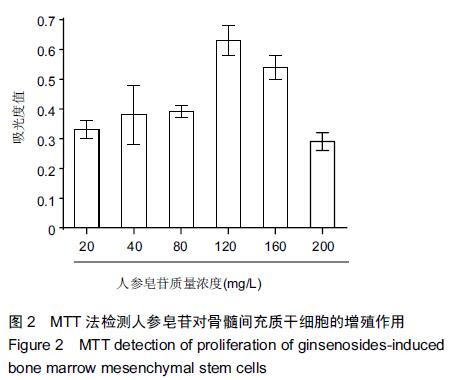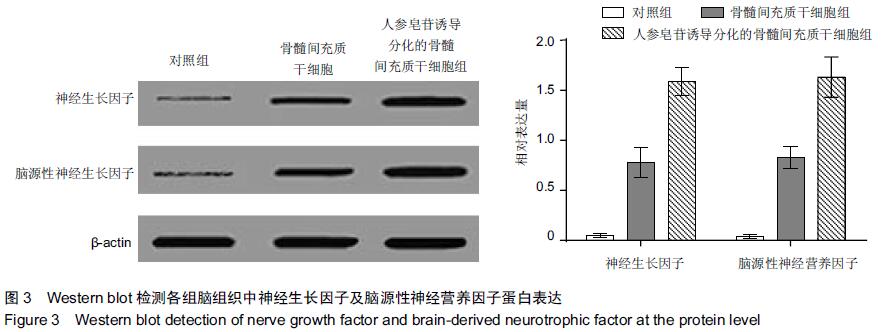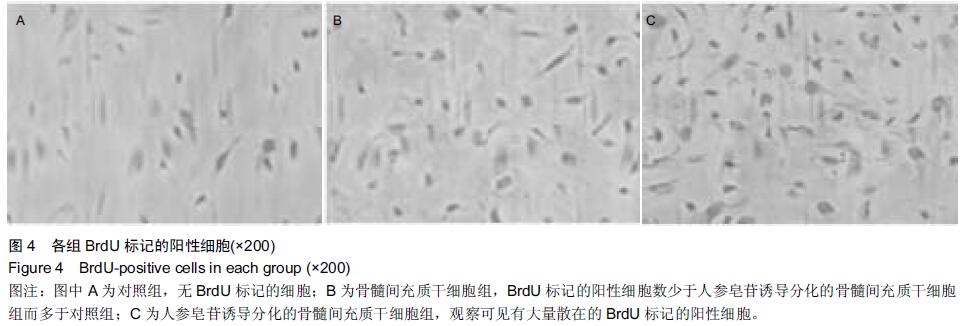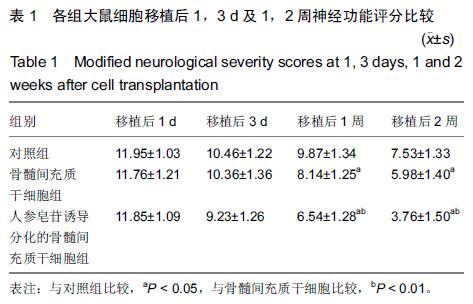[1] 杨国强,范学慧,萧洪文,等.骨髓间充质干细胞移植治疗缺血性脑损伤的最新研究进展[J].四川解剖学杂志,2013,21(3):32-35.
[2] Liu Z, Li Y, Zhang ZG, et al. Bone marrow stromal cells enhance inter- and intracortical axonal connections after ischemic stroke in adult rats. J Cereb Blood Flow Metab. 2010; 30(7):1288-1295.
[3] 曹文锋,王卫真,高幼奇,等.立体定向移植骨髓间充质干细胞对脑缺血再灌注模型大鼠的治疗作用[J].中国神经精神疾病杂志, 2011,37(7):385-389.
[4] Wakabayashi K, Nagai A, Sheikh AM, et al. Transplantation of human mesenchymal stem cells promotes functional improvement and increased expression of neurotrophic factors in a rat focal cerebral ischemia model. J Neurosci Res. 2010;88(5):1017-1025.
[5] 于晓云,张博爱,李俊敏,等.骨髓间充质干细胞移植对慢性脑缺血大鼠海马区Cdc42表达及认知功能的影响[J].中国老年学杂志, 2013,33(4):829-831.
[6] Charbord P, Livne E, Gross G, et al. Human bone marrow mesenchymal stem cells: a systematic reappraisal via the genostem experience. Stem Cell Rev. 2011;7(1):32-42.
[7] 郭继东,王月,信宏,等.骨髓间充质干细胞移植对缺血性脑卒中大鼠的细胞外信号调节蛋白激酶的影响[J].中风与神经疾病杂志, 2010,27(12):1124-1125.
[8] Li J, Zhu H, Liu Y, et al. Human mesenchymal stem cell transplantation protects against cerebral ischemic injury and upregulates interleukin-10 expression in Macacafascicularis. Brain Res. 2010;1334:65-72.
[9] Zheng W, Honmou O, Miyata K, et al. Therapeutic benefits of human mesenchymal stem cells derived from bone marrow after global cerebral ischemia. Brain Res. 2010;1310:8-16.
[10] 李晓晓,张博爱,李俊,等.骨髓间充质干细胞移植对慢性脑缺血大鼠认知功能及海马CAl区EphB2的影响[J].中风与神经疾病杂志, 2013,30(2):104-107.
[11] Jin P, Zhu L, Zhang J, et al. A correlation study of the expression of resistin and glycometabolism in muscle tissue after traumatic brain injury in rats. Chin J Traumatol. 2014; 17(3):125-129.
[12] 王德健,黄源芳,李巧云,等.人参皂苷 Rg1 抗新生鼠缺氧缺血性脑损伤后神经元凋亡的研究[J].中国修复重建外科杂志,2010, 24(9):1107-1112.
[13] 李永领,项洪武,朱烈烈,等.人参皂苷对重度颅脑外伤大鼠模型环氧合酶-2表达的影响[J].中国中医急症,2010,19(9):1556-1557.
[14] 张洪连,谢旭芳,吴凌峰,等.尾静脉移植骨髓间充质干细胞对脑缺血再灌注大鼠模型的治疗作用[J].中风与神经疾病杂志,2011, 28(2):115-119.
[15] Kawabori M, Kuroda S, Ito M, et al. Timing and cell dose determine therapeutic effects of bone marrow stromal cell transplantation in rat model of cerebral infarct. Neuropathology. 2013;33(2):140-148.
[16] 周玲,邓莉,涂江义,等.GDNF基因修饰的BMSCs在脑出血大鼠脑内存活与分化的实验研究[J].实用医学杂志,2012,28(1): 48-51.
[17] Komatsu K, Honmou O, Suzuki J, et al. Therapeutic time window of mesenchymal stem cells derived from bone marrow after cerebral ischemia. Brain Res. 2010;1334:84-92.
[18] 先德海,余崇林.骨髓间充质干细胞治疗创伤性脑损伤的研究进展[J].泸州医学院学报,2015,35(3):337-339.
[19] Yin F, Guo L, Meng CY, et al. Transplantation of mesenchymal stem cells exerts anti-apoptotic effects in adult rats after spinal cord ischemia-reperfusion injury. Brain Res. 2014;1561: 1-10.
[20] Hou Y, Ryu CH, Jun JA, et al. IL-8 enhances the angiogenic potential of human bone marrow mesenchymal stem cells by increasing vascular endothelial growth factor. Cell Biol Int. 2014p;38(9):1050-1059.
[21] 朱烈烈,陈大庆,李永领,等.人参皂苷对大鼠重型脑外伤后神经细胞凋亡的保护作用及其机制研究[J].中华中医药学刊,2009, 27(12):2554-2557.
[22] 李英博,涂柳,陈笛,等.人参皂苷Rg1处理的人神经干细胞对缺氧缺血脑损伤的功能恢复研究[J].中国中药杂志,2012,37(4): 509-514.
[23] Dong XQ, Yang SB, Zhu FL, et al. Resistin is associated with mortality in patients with traumatic brain injury. Crit Care. 2010;14(5):R190.
[24] 陈健文,潭敏谊,陈浩凡,等.人参皂苷Rb3对脑缺血-再灌注后大鼠脑组织中兴奋性氨基酸的作用研究[J].中药材,2012,35(8): 1301-1304.
[25] 朱烈烈,戴慧芳,李永领,等.创伤性脑损伤大鼠RSTN 基因表达与人参皂苷的干预作用[J].中华中医药学刊,2015,33(7): 1687-1689.
[26] 杨松斌,王克义,竹方龙,等.重型脑外伤患者血浆抵抗素水平动态变化与预后的关系[J].中国临床神经科学,2011,19(3):265-269.
[27] 陈大庆,朱烈烈,李永领,等.人参皂甙Rg1 对颅脑损伤模型大鼠神经细胞凋亡的影响[J].实用医学杂志,2010,26(1) :30-31.
[28] Geng CK, Cao HH, Ying X, et al. Effect of mesenchymal stem cells transplantation combining with hyperbaric oxygen therapy on rehabilitation of rat spinal cord injury. Asian Pac J Trop Med. 2015;8(6):468-473.
[29] 马宁,蔡继福,姜卫剑,等.局灶性脑缺血动物模型的制备[J].神经损伤与功能重建,2010,5(1): 53-55.
[30] Yin F, Meng C, Lu R, et al. Bone marrow mesenchymal stem cells repair spinal cord ischemia/reperfusion injury by promoting axonal growth and anti-autophagy. Neural Regen Res. 2014;9(18):1665-1671.
[31] Hu BY, Liu XJ, Qiang R, et al. Treatment with ginseng total saponins improves the neurorestoration of rat after traumatic brain injury. J Ethnopharmacol. 2014;155(2):1243-1255.
[32] Hu BY, Jiang ZL, Wang GH, et al. Effective dose and time window of ginseng total saponins treatment in rat after traumatic brain injury. Zhongguo Ying Yong Sheng Li Xue Za Zhi. 2012;28(2):179-183.
[33] Xia L, Jiang ZL, Wang GH, et al. Treatment with ginseng total saponins reduces the secondary brain injury in rat after cortical impact. J Neurosci Res. 2012;90(7):1424-1436.
[34] Li H, Deng CQ, Chen BY, et al. Total saponins of Panax notoginseng modulate the expression of caspases and attenuate apoptosis in rats following focal cerebral ischemia-reperfusion.J Ethnopharmacol. 2009;121(3): 412-418.
[35] Zhang CL, Wen DJ, Dong XG. Effect of total Panax japonicus saponins on the contents of the excitatory amino acid in the brain tissue of rat with cerebral ischemia. Zhongguo Ying Yong Sheng Li Xue Za Zhi. 2008;24(4):473-474, 482.




